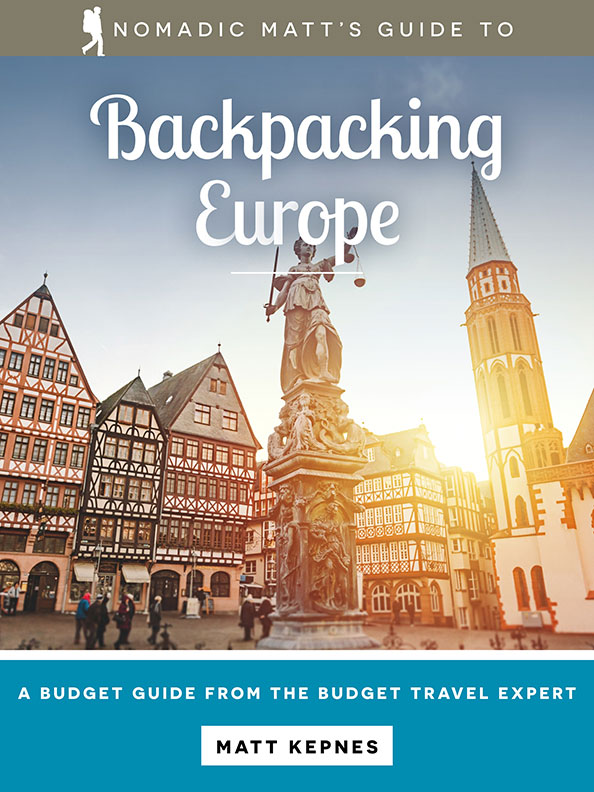
Last Updated: 9/13/21 | September 13th, 2021
When I planned my move to Sweden a few years ago, I tried to figure out how to get past the 90-day limit placed on tourist visas in the Schengen Area. This is a problem encountered by thousands of travelers every year and a question that regularly (especially this time of year) pops up in my inbox.
“How can I stay in Europe for more than 90 days?”
It’s a simple question with a very complicated answer.
I always knew it was complicated, but until I started researching how to stay there longer, I never knew just how complicated.
Fortunately, in the process of this research, I came to learn there are a few ways to stay in Europe longer than 90 days; they just aren’t well known.
This post will teach you the options for staying in Europe over 90 days as well as give you tips on how to move to Europe. But first a few things:
It’s important to note that Europe isn’t just one place — there are varying visa rules throughout the continent. When people talk about the “90-day limit,” they’re talking about restrictions on the Schengen Area, which is the visa policy that governs 26 countries in Europe. It includes all of the European Union — except Ireland — as well as a few non-EU countries.
Note: While I call it the “Schengen Visa,” it’s not an actual visa you necessarily need to apply for. Depending on your residency status and country of citizenship, you may need to apply in advance for a Schengen Visa, however, those with an American passport do not need to apply in advance.
Table of Contents
- What is the Schengen Visa?
- Part 1: Staying or Moving to Europe the Easy Way
- Part 2: Staying in the Schengen Area Past 90 Days
- Can You Extend Your Schengen Visa/Stamp?
- Getting a Working Holiday Visa
- Getting a Long-Term-Stay Visa
- Student Visas
- Freelancer Visas
- Marriage Visas
- Further Europe Travel Planning Articles
What is the Schengen visa?
The Schengen visa is a 90-day tourist visa for Schengen Area countries, which are:
- Austria
- Belgium
- Czechia
- Denmark
- Estonia
- Finland
- France
- Germany
- Greece
- Hungary
- Iceland
- Italy
- Latvia
- Lithuania
- Liechtenstein
- Luxembourg
- Malta
- Netherlands
- Norway
- Poland
- Portugal
- Slovakia
- Slovenia
- Spain
- Sweden
- Switzerland
Additionally, there are several microstates that are de facto members of the Schengen Area. These are Monaco, San Marino, and Vatican City.
These Schengen countries have a border-free visa agreement that lets residents move throughout the Area without needing to show their passport every time they cross a border. Essentially, it’s as if they’re one country, and you can move as freely as you want.
Citizens of many countries are allowed to enter the Schengen Area without having to get a visa beforehand. Your passport simply gets stamped upon your arrival and departure from Europe. You’re allowed to enter and leave from any country you want — they don’t have to be the same.
Here is a map of the countries with visa waivers that can enter the Schengen without requiring a visa in advance.
Most visitors (including Americans) are allowed to spend 90 days in the Schengen Area in every 180-day period. The easiest way to think of it is that you can visit for 3 months and then you have to leave for 3 months before you can return.
However, you can also bounce back and forth between Schengen and non-Schengen countries — you just need to keep track of all your dates of entry/exit.
When I visit Europe, I fly in and out of different countries all the time. Your first entry in the 180-day period is when your 90-day counter starts. These days don’t need to be consecutive — the total is cumulative. Once day 181 hits, the count resets itself.
For example, if I come to the Schengen Area in January and stay for 60 days and then come back in June for 10 days, that counts as 70 days in 180 days. Only days you are in the zone during the period count. If you go on January 1st and stay 90 straight days, you have to leave and technically can’t come back until July 1st.
However, not all travelers are allowed such freedom.
Citizens from many countries need to apply for a Schengen visa ahead of time. You’ll be required to fill out paperwork beforehand and fly in and out of the country for which your visa is issued.
Even then, you still might not be granted a visa. Spoiler alert: citizens from African and Asian countries get screwed.
So, with that being said, how DO you stay in Europe longer? How do you get around that rule? Let me break it down for you.
Part 1: Staying or Moving to Europe the Easy Way

With so many visa rules, it’s easy to stay in Europe beyond 90 days as a tourist — you just need to mix up the countries you visit. The United Kingdom has its own rules that allow you to stay 180 days in a calendar year.
Most non-Schengen countries such as Ukraine, Moldova, Croatia, Ireland, and some Balkan countries allow you to stay for up to 60 or 90 days. Albania even lets American’s stay up to a year!
So, all you need to do to stay in Europe longer than 3 months is spend 90 days in the Schengen Area and then visit the UK, go to the Balkans, hang out in Ukraine, drink wine in Moldova, and have a pint in Ireland. If you align your schedule right, you can easily be out of the Schengen Area for 90 days and then head back into the Schengen Area with a brand new Schengen visa.
Years ago, to get around this limit, I spent three months in Bulgaria, Romania, Ukraine, and England as I waited for my clock to reset. After that, I headed back into the Shengen area for Oktoberfest.
If you want to travel the continent for a long time without having to go through the various visa processes described below, vary your travel by visiting non-Schengen countries. There’s plenty of countries to choose from while you wait for your Schengen Visa clock to reset. This is the easy, hassle-free way of doing things.
—-> Need more tips for Europe? Visit my destination guide and get in-depth information on what to see and do and how to save money.
Part 2: Staying in the Schengen Area Past 90 Days

But what if you do want to stay longer in the Schengen Area? What if the six months you want to be in Europe is all in Schengen Area countries? What if you want to live and work in Europe?
After all, the Schengen Area spans 26 countries and visiting so many destinations in 90 days can be a little rushed (you would have an average of just 3.5 days per country).
If you want to stay longer to travel, live, learn a language, or fall in love, then the “move around” option suggested above isn’t going to work for you. You need something else.
Luckily, there are a few ways to do this — and I can’t stress enough the importance of the word “few.” Because staying more than 90 days in the Schengen Area isn’t easy.
First, let’s understand the rule:
The Schengen law states that you can’t stay in the Area for more than 90 days. If you do, you’re subject to a fine and possibly deportation and being banned from re-entering the Schengen Area. How that rule is enforced, though, varies greatly from one country to another. Overstaying by a day might not be the end of the world, however, some countries do not mess around with visitors overstaying.
For example, Germany, the Netherlands, Poland, Switzerland, and Scandinavian countries are all very strict about entry and exit rules. If you overstay your tourist visit, there’s a good chance they’ll pull you aside. Two Australians I know were detained leaving Switzerland due to overstaying their visa by two weeks. They were allowed to go with just a warning, but they missed their flights and had to book new flights.
I know of someone who overstayed by six months, tried to leave from Amsterdam, and now has an “illegal immigrant” stamp on her passport. In order to enter Europe again, she must apply for a visa at an embassy and be preapproved:
I made the mistake of attempting to leave from the Netherlands after overstaying a Schengen visa and was caught. I overstayed by about a month, and they hand-drew some sort of insignia in my passport to note my overstay. They told me I’d have to contact the IND and find out if I would be able to enter the Schengen states again.
Another blogger told me this happened to them too so don’t overstay your visa!
That being said, if you leave from Greece, France, Italy, or Spain you may be less likely to encounter an issue, provided you (a) haven’t stayed over too long and (b) didn’t catch the immigration officer on a bad day.
When I left Greece, no one even looked at my passport. One of my friends met a guy in France, fell in love, and decided not to leave. A year later, when she finally did, the French officials didn’t even look twice. Another friend flew into France and didn’t even get an entry stamp. Spain is another place notorious for not caring and Americans who decide to overstay for months mention that as the easiest country to exit from.
Of course, I don’t think it’s wise to overstay. A day or two? Likely not the end of the world. But, Matt, can I extend just extend my Schengen visa/stamp?
Unfortunately not. Simply put, you cannot extend your tourist visa or entry stamp. There’s a 90-day limit, and that’s that.
So what’s a tourist to do?
1. Get a Working Holiday Visa

Working holiday visas are easy to get and the best way to extend your stay — even if you don’t want to work. These visas are designed for young travelers who want to work and travel abroad. Citizens of Australia, Canada, and New Zealand (and often South Korea, Israel, Hong Kong, and Japan) are eligible for one- to two-year working holiday visas from most of the Schengen countries.
There is no single “working holiday” program for the Schengen or EU so applicants must apply for this visa from a specific country. Applicants must also be younger than 30 (though, in some cases, like for Canadians working in Switzerland or Ireland, you can be as old as 35).
Additionally, you can get consecutive working holiday visas. An Australian reader of mine got a two-year Dutch working holiday visa and then got one from Norway to stay two more years. While she and her boyfriend (who also got one) did odd jobs in Holland for a bit, they mostly used it as a way to travel around the continent.
Note: This type of visa won’t allow you to work in any other country than the one that issued it.
For Americans, there are only two options for working holidays in Europe: Ireland (non-Schengen country) and Portugal (Schengen country). The Portuguese working holiday visa is for travelers aged 18-30 and lasts two years. The Irish one also lasts two years and is good for those aged 18-30, however, you must have graduated within 12 months of applying (or be a student).
2. Get a Long-Term-Stay Visa

Unfortunately, the majority of Schengen countries do not offer long-term-stay visas for tourists/visitors. Generally speaking, if you want a long-stay visa, you’d have to apply for residency.
Schengen allows for a C- or D-class visa (the letter varies on the country), which is a temporary residence visa for up to one year. But the specific visa and requirements vary from country to country. Some countries are harder, some are easier, and others are nearly impossible despite being in the same visa treaty zone.
However, there are a few countries that do offer long-term visas that aren’t too hard to get:
France
France offers a long-term visitor visa for a period of up to one year. The application process takes up to one month. According to the French Embassy, “The ‘visitor’ visa (or visa ‘D’) allows you to enter France and stay for more than three months. Long-stay visa holders will be allowed to reside in France for up to 12 months according to the validity of their visa and purpose of stay.”
To get this visa, you must set up an appointment at the French consulate near you. You can’t walk in — you must make an appointment.
At this appointment, you’ll need the following documents:
- One application form filled out completely and signed
- Three passport photos
- Your original passport, which must have been issued less than 10 years ago, be valid for three months after your return, and have at least two blank pages left
- A letter certified by a notary public that promises you won’t engage in work
- A letter of employment stating current occupation and earnings
- Proof of income (you’ll need bank statements or copies of your investment portfolio)
- Proof of medical insurance that includes evacuation insurance
- Proof of accommodation in France. (The French consulate never returned my emails, so I was unsure how you could have this before you even get to France. One could use a friend’s address or, lacking that, rent a place (one where you can get a refund) for the purposes of the interview. It’s a little fuzzy.)
Note: You can’t apply for this visa more than three months before your arrival date.
You can visit the French Embassy website for links to local embassies and consulates for more information. This post also has some helpful information to get you started.
Sweden
Sweden also offers a long-term stay tourist visa for a maximum period of one year. The process is easy usually takes around two weeks to process when applied for in Sweden. Here’s a brief overview of what you need:
- Residence permit for visitor’s application form
- Notarized copies of the pages of your passport that show your identity and the validity of your passport, as well as copies of all the other visas/stamps you have. Your passport also needs to be valid for 3 months after your stay.
- A bank statement showing your means of supporting yourself for the duration of your stay (you need at least $52 USD per day for each day saved in your account)
- A return airplane ticket
- A letter from your insurance company stating you’re covered overseas
Applications can be delivered in person during visiting hours (no appointment needed) or mailed to a Swedish consulate.
After your documents are received, you’ll be required to have an interview with one of the immigration officers. Most people who apply for this visa have family in Sweden. If you don’t, you’ll need to have clear reasons as to why you need to stay longer and show ample proof that you can support yourself (i.e., “I want to meet Swedish guys/girls” won’t cut it!). If you’re applying in Sweden, you’ll need to put a local’s address on your application form, and that person will have to accompany you to your interview.
You can learn more about the process on this government page.
Spain
Spain offers a long-term visa targeting retirees called the Non-Lucrative Residence Visa. It requires that you spend at least 183 days in Spain, which would make you a legal resident for tax purposes here. During this time, you are unable to work in Spain (so you’ll need to have enough savings to get you by). However, studying and unpaid internships are permitted.
The big catch for this visa is that you need to have over 27,000 EUR in your bank account. That’s around $32,000 USD. Since the visa is designed for retirees, the assumption is that you’re coming here to rest on your financial laurels after a lifetime of saving up — hence the sizeable requirement.
The visa has been denied to people who are remote workers so I wouldn’t recommend this visa if you’re a digital nomad (Spain is currently working on a visa specifically for distal nomads though it’s not currently available).
In addition to having sizable savings, you’ll also need to fill out the application, submit your passport and additional photos, pay a fee, and provide the following:
- Proof of private health insurance (from an authorized company in Spain)
- A doctor’s note certifying that you’re healthy
- A criminal background check translated into Spanish
You must apply for this visa in your country of residency as you will be interviewed as part of the process. The application varies per country, usually between 120-520 EUR (it’s around 125 EUR for Americans and just over 500 EUR for Canadians).
This consulate page has all the specific details you need regarding the application.
Portugal
Portugal has multiple long term stay visas. First, there is a Golden Visa, which requires a minimum investment in the country of $300,000 USD. More realisticly, is the D7 visa, which is similar to Spain’s retirement visa.
It requires proof of insurance, a background check, an application and interview, etc. The main difference, however, is that you only need an income of around $9,000 USD instead of the $32,000 USD in savings the Spanish visa required. You still cannot work on this visa, so your income must be passive (investments, pension, rental property, etc.).
The D7 visa can work for digital nomads, though there is a separate visa that might work better: the D2 visa.
This visa, known as the Immigrant Entrepreneur visa, isn’t designed specifically for digital nomads. You’ll need to submit a business plan and demonstrate you have enough capital to get started. You’ll also need to explain why you want to start (or move) your business to Portugal. You’ll have a much higher chance of getting approved if you have invested upwards of 5,000 EUR in your business and speak some Portuguese as well (it’s not required, but these visas are regularly rejected so it will give you a leg up).
In short, there are a lot of steps for a temporary visa that only lasts one year. However, you can get this extended and eventually apply for permanent residency or citizenship after 5 years.
You’ll need to apply for both of these visas in your country of residency.
A note of long-term visas: Keep in mind that the information above is just for reference. There may be more requirements needed for your application and not all visas are open to everyone. You’ll want to contact your local embassy for specifics and additional information.
The Bilateral Agreement Hack

In addition to the standard Schengen visa, most countries have numerous bilateral agreements independent of the Shengen visa. These agreements let travelers stay in a specific country for an additional period of time beyond the 90-day Schengen limit. The only caveat is that can’t leave that country during that time.
For example, France has a bilateral agreement that allows U.S. citizens to stay an additional 90 days beyond the Schengen limit. You can enter from any Schengen country, stay 90 days in France, and then fly home. But the catch is you have to go home — you can’t go elsewhere. You have to leave Europe so you can’t use your time in France as a sneaky way to reset your Schengen clock.
Now, the France/U.S. rule is tricky. It’s based on a post-WW2 agreement that never was cancelled. Multiple French consulates told me yes, they thought this law existed but couldn’t tell me where to find it. A few visa services told me I was crazy. One consulate told me it was possible but only with a long-term visa.
BUT, after many calls, the US, Canda, and Uk French embassies told me that yes, this law does exist and that yes, this is still valid. Then they referenced me to the French national archives.
Well, we found the actual diplomatic papers that spell this out. It took us close to a year to find it but we did.
This is the note from the French government about it:
Hi,
There is a bilateral agreement between French and the U.S. by exchange letters (March 16-31 mars 1949), which allows American citizens to stay in France 90 days over 180 days, irrespective of the stays already made in other Schengen countries.
However, this agreement has been made before the Schengen agreement. Today, as there is no more border control between the Schengen countries, it is very difficult to determine how long a person has stayed in France and we heard that some people had troubles with the immigration police while leaving France.
Therefore, we recommend American citizens to respect the Schengen regulation which allows a maximum of 90 days on 180 days in the whole Schengen area.
Consulat général de France, Service des visas
4101 Reservoir Road, Washington DC, 20007
A follow to the London embassy gave me this response:
“Whilst the bilateral agreement you refer to has not officially been revoked, the French Border Police has sole authority on deciding whether to apply it or not, at the time of entering or exiting the Schengen area.”
So this is really a thing. And, while they don’t like you using it, it’s still the law. Just bring proof you stayed in France for 90 days! If you plan to use this rule, bring documentation as border guards my not be aware of it.
Additionally, Denmark and Poland also have bilateral agreements with the United States that let citizens stay an additional 90 days in each country separate from the regular Schengen Zone visa. The Denmark rule applies exactly the same way as the French one. Denmark also has a bilteral agreemnt that is applicable for citizens of Australia, Canada, Chile, Israel, Japan, Malaysia, New Zealand, Singapore, and South Korea.
For Poland, you must enter and leave Poland via a non-Schengen country where you will be stamped again (i.e., direct flight from NYC). So you could do 90 days in the Schengen, fly to the UK, and then fly to Poland. Poland’s rules are simply laid out in an agreement letter the U.S. and Poland signed in 1991. (Here’s a copy of the letter from the Polish government).
In theory, there are also other bilateral agreements between the U.S. and Schengen countries. I’ve been told by multiple sources that Belgium, Italy, Hungary, Norway, Spain, Portugal, and the Netherlands all have their own bilateral agreements with the U.S. as well. This page outlines the existing bilateral agreements.
However, I reached out to each country’s consulate and none of them replied (save Portugal) in any meaningful way. They simply directed me to the standard visa FAQ page.
Regarding Portugal, a representative from the Portuguese consulate said this regarding their bilateral 60-day visa:
Please note that those 60 days are an exceptional extension that needs to be requested within Portugal at SEF office near your temporary address in Portugal.
Now, in theory, one could say thanks to borderless travel you could get your “extra 90 days in Denmark” and then just travel around, fly out of Denmark, and no one would be the wiser. One could say that. But I’ve noticed a lot more intra-Europe passport checks in recent years. I got yelled at in France for not having my passport with me while on a train to see a chateau. So, I wouldn’t recommend doing this.
Note: Most counties have bilateral agreements with other countries. Call the local embassy for more information (you’ll have better luck calling than emailing).
3. Get a Student Visa
All Schengen Area countries offer student visas that are easy to obtain so long as you’re enrolled in a recognized university program. This would require you to pay for the course, but it will virtually guarantee you a visa if you are accepted.
One of the best countries to do this in is Spain, where a whole industry has sprung up to help students study Spanish. There are tons of schools that will allow you to enroll and write letters stating you’re a student there. You’ll need to apply in your home country but the process is relatively straightforward. This post details the requirements.
Germany is another popular choice, as post-secondary schools there are essentially free. While there may be more competition, the costs are much lower. You can learn about the application process here.
While most student visas allow you to stay in a country for one year, I would only consider getting one if you actually plan on studying. If you’re just getting a student visa to travel and play tourist, it’s not going to be worth the cost and paperwork since you’ll need to set up everything from a residential address to a bank account to a local phone number and more.
4. Get a Freelancer Visa
There are several countries that offer freelancer visas. This process is a little more complicated and not for the casual tourist. These visas are meant for people who actually want to live and work in Europe. If you’re just a casual tourist, expect to be denied. But if you’re a digital nomad, this is the visa for you.
Schengen countries that offer freelancer visas include Germany, Estonia, Spain, Czechia, Portugal, Greece, and Malta. Non-Schengen countries that have them include Croatia, Romania, Georgia, and Iceland.
Germany is the country most used by people who want to reside in Europe. If you’re a freelancer, digital nomad, artist, or have some form of income, this is the visa to get (and it’s quite easy to get). If you are from Australia, Canada, New Zealand, the U.S., Israel, South Korea, or Japan you can apply after you arrive in Germany (everyone else needs to apply in advance).
The visa only lasts for three months, however, it is designed to be extended into a residency visa which would then last for three years. I have many friends who have gotten this visa. As long as you follow the steps, you should be fine. This post has more information about the process.
Most freelancer visas follow a similar format: apply, pay a fee, submit proof that your business can stay afloat, then wait to be accepted. However, some have more stringent requirements.
For example, Estonia’s freelancer visa requires a monthly income of at least 3,500 EUR per month leading up to your application. For the Czechia visa, you need to have at least $6,000 USD in your bank account (the lovely folks at Wandertooth, who did this process a couple of years ago, can walk you through the steps).
In recent years, Spain has also created freelancer visa called the “autonomo” that also follows a similar process. You can read more here.
If you are a digital nomad and are considering working remotely from the EU you can compare these programs to see which one bests suits your goals (though Germany is likely the best place to start since it’s one of the easiest to get).
5. Get Married to a European
Fall in love with a European (or at least a friend) and apply for a marriage visa! You’ll get to stay there while the application process goes through and then you can move to Europe and stay there forever with the love of your life! That’s a win-win! (This is a joke. Don’t get married just for a visa to stay in Europe!)
***
The best, easiest, and most effective way to stay in Europe long-term is to increase the number of countries you visit so you’re in the Schengen Area for only 90 days. As I said, there are a lot of countries not in the Area so this is easy to do.
If you’re like me and want to stay in the Schengen Area longer than 90 days (or just want to move to Europe because it’s awesome), be prepared to work the system. Iit’s not impossible to stay long-term in the Schengen Area. By understanding the system and using the few loopholes that do exist, one can legally stay past 90 days and enjoy all Europe has to offer without worrying about being barred for life.
Get Your In-Depth Budget Guide to Europe!

My detailed, 200+ page guidebook is made for budget travelers like you! It cuts out the fluff found in other guidebooks and gets straight to the practical information you need to travel and save money while backpacking around Europe. You’ll find suggested itineraries, budgets, ways to save money, on and off the beaten path things to see and do, non-touristy restaurants, markets, and bars, and much more! Click here to learn more and get started!
Book Your Trip to Europe: Logistical Tips and Tricks
Book Your Flight
Use Skyscanner or Momondo to find a cheap flight. They are my two favorite search engines because they search websites and airlines around the globe so you always know no stone is left unturned. Start with Skyscanner first though because they have the biggest reach!
Book Your Accommodation
You can book your hostel with Hostelworld as they have the biggest inventory and best deals. If you want to stay somewhere other than a hostel, use Booking.com as they consistently return the cheapest rates for guesthouses and cheap hotels.
For suggestions on where to stay during your trip, here is a list of my favorite hostels in Europe.
Don’t Forget Travel Insurance
Travel insurance will protect you against illness, injury, theft, and cancellations. It’s comprehensive protection in case anything goes wrong. I never go on a trip without it as I’ve had to use it many times in the past. My favorite companies that offer the best service and value are:
- World Nomads (for everyone below 70)
- Insure My Trip (for those over 70)
- Medjet (for additional repatriation coverage)
Looking for the Best Companies to Save Money With?
Check out my resource page for the best companies to use when you travel. I list all the ones I use to save money when I’m on the road. They will save you money when you travel too.
Want More Information on Europe?
Be sure to visit our robust destination guide on Europe for even more planning tips!
NOTE: Due to the complexities of visas and the uniqueness of everyone’s situation, we do not answer any visa related questions in the comments or via email. Thank you.
The post How to (Legally) Stay in Europe for More Than 90 Days appeared first on Nomadic Matt's Travel Site.
-------------------------
By: NomadicMatt
Title: How to (Legally) Stay in Europe for More Than 90 Days
Sourced From: www.nomadicmatt.com/travel-blogs/how-to-legally-stay-in-europe-for-more-than-90-days/
Published Date: Mon, 13 Sep 2021 12:30:00 +0000
Read More
 General Health and WellnessFitness and ExerciseSupplements and VitaminsPandemic NewsVideosPrivacy PolicyTerms And Conditions
General Health and WellnessFitness and ExerciseSupplements and VitaminsPandemic NewsVideosPrivacy PolicyTerms And Conditions
